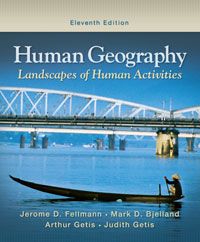1 A) declining. B) fluctuating without a trend. C) increasing. D) remaining about the same. 2 A) hunter-gatherers. B) intensive commercial agriculture. C) subsistence agriculturists. D) urban-industrial people. 3 A) of pre-Columbian voyages from the Mediterranean to the Americas. B) of the diffusion of the pyramidal form across the Bering land bridge. C) of the reality of independent parallel invention. D) the Mayans were descended from the ancient Egyptians. 4 A) Andean region B) Eastern Brazil C) Mesopotamia D) Syria 5 A) complex, realm, region, trait B) realm, complex, region, trait C) realm, region, complex, trait D) trait, complex, region, realm 6 A) East Asia – coffee, cotton, okra, sorghum B) Mediterranean – barley, celery, grapes, olives C) Meso-America – beans, maize, manioc, squash D) Southern and Southeastern Asia – papaya, potato, pumpkin, tomato 7 A) cultural ecology. B) cultural convergence. C) cultural diffusion. D) culture hearth. 8 A) sophisticated agricultural societies based upon irrigation. B) subsistence tribal systems based on hunting and gathering. C) the complete absence of human populations as we know them. D) the development of culture hearths based on urban centers. 9 A) permeable B) contagious C) expansion D) relocation 10 A) expansion B) hierarchical C) permeable D) relocation 11 A) Egypt. B) Mesopotamia. C) Minoan Crete. D) West Africa. 12 A) the destruction of many species of plants from excessive use of fire by Stone Age societies. B) the massive loss of human life resulting from the onset of glaciation. C) the rapid increase in Paleolithic population due to warming of continents. D) the Stone Age loss of whole species of large animals on inhabited continents. 13 A) abandonment as centers of culture and settlement in modern times. B) clustering in a band around the earth between 20 degrees south and 40 degrees north latitude. C) confinement to lowland river valleys. D) location on the western sides of continental land masses. 14 A) acculturation B) diffusion C) innovation D) segregation 15 A) Andean Uplands. B) Eastern Brazil. C) Meso-America. D) West Africa. 16 A) house types B) kinship C) size of settlements D) transportation networks 17 A) diffusion and religion. B) innovation and diffusion. C) innovation and language. D) language and religion. 18 A) gross national product per capita B) land and property ownership systems C) literature D) schools 19 A) Mesolithic B) Neolithic C) Paleolithic D) Pleistocene 20 A) cultural convergence. B) environmental determinism. C) multilinear evolution. D) possibilism. 21 A) contagious diffusion. B) the destruction of the life supporting environment. C) the domestication of animals, particularly horses. D) environmental determinism. 22 A) delaying the path of diffusion. B) adoption of the traits of a more dominant culture. C) fusing the old and new elements of culture. D) rigorously organizing agriculture activities. 23 A) Mesolithic B) Neolithic C) Paleolithic D) Pleistocene 24 A) merging of the original culture hearths. B) sharing of technologies, organized structures, and culture traits among separated societies. C) process of acculturation. D) abandonment of older culture hearths for modern centers. 25 A) all B) none C) only those in the Americas D) only the Asian hearths





